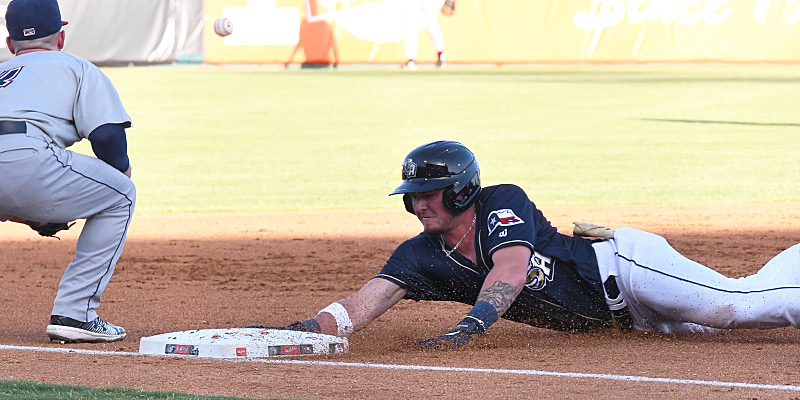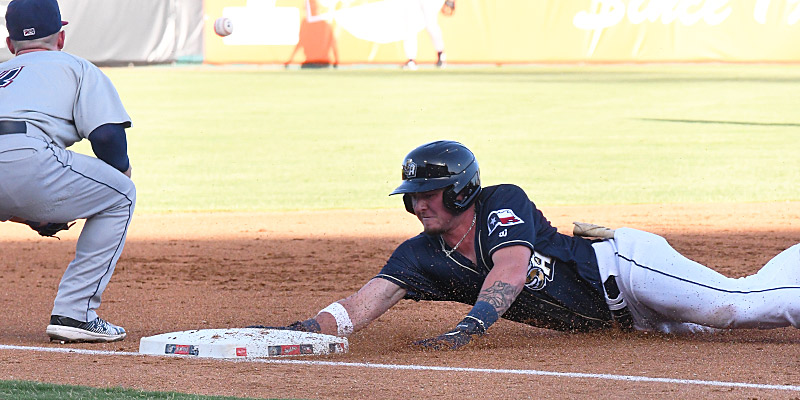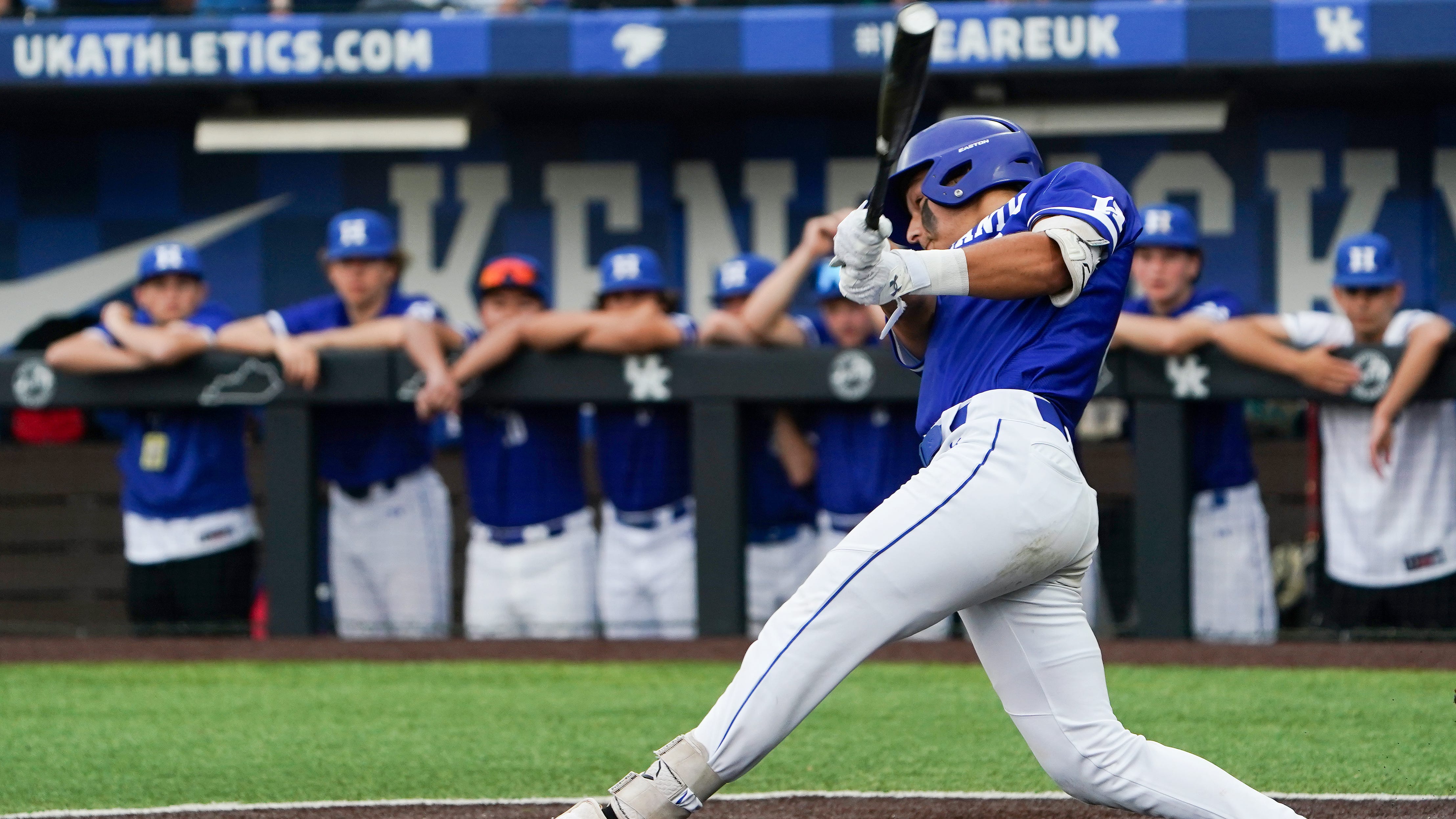
SAN ANTONIO — The 2025 season has been a magical campaign for Missions catcher Brandon Valenzuela, as the 24-year-old has posted career-high power and run-production numbers with a .471 slugging percentage and a 140 wRC+.
Saturday night, as the Missions hosted “Harry Potter Night” at Wolff Stadium, Valenzuela summoned a bit more magic to deliver a walk-off single to lift the Missions to a 3-2 victory and sole possession of first place in the Texas League South standings.
“Isn’t that what the game is all about,” said Missions manager Luke Montz. “You look at growth; you look at development. You’re seeing a young kid progress.
“The next step for Brandon is to get into the big leagues and show what he can do. What they’re looking for is moments right there. It’s not always about the outcome, if it’s a hit or not a hit. It’s just the at-bat. There is just no giving in with him, and he is not an easy out right now in the box. I am super shocked they pitched to him there in that situation with first base open.”
While Valenzuela’s bat ultimately brought the Missions to victory, their pitching staff kept them alive for most of the night. Jagger Haynes delivered a stellar performance when his team needed it. The 22-year-old southpaw worked six innings, allowing just one run on four hits and a walk, and struck out five. The lone run Haynes surrendered on the night was a lead-off homer to Cameron Cauley.
![]()
Jagger Haynes has been stellar over the last month. (Photo: Rey Holguin)
Haynes generated 10 total whiffs, resulting in an excellent 29.4% whiff rate on the night. His sinker sat 92-93 mph, getting anywhere from 11-14 inches of horizontal run. Haynes’s changeup was also effective running away from right-handed hitters. It sat at 82-83 and continued to flash an ample arm-side fade. He also showed a knack for getting whiffs with his gyro-slider, inducing three in the first inning alone, including two by Rangers top prospect Sebastian Walcott.
Over his last five starts, Haynes has a 1.98 ERA with 23 strikeouts against 14 walks in 27.1 innings of work. After showing he could shoulder starting pitching workloads last year, the lefty has already worked into the sixth inning six times this season.
“All of our starters have given us a chance to win every single game this week,” said Montz. “A solo home run to start the game can easily rattle somebody and shift momentum to their dugout. But then what Jagger goes and does is retire the next six in a row and give us six innings of one-run ball.”
“It just speaks volumes to where he’s at in his growth and development. Earlier in the year, I’m not sure we’re talking about that. We might get him in the second or third inning. But he’s starting to show that he can handle adversity and control what he can control.”
With Haynes locked in, the Missions offense quickly evened things up in the bottom of the second when Francisco Acuña lined a double to the left field gap to plate Wyatt Hoffman. Acuña finished the night with two hits and a pair of walks out of the leadoff spot. He has his average up to .344 this month.
Following Haynes’ departure, Montz turned the game over to Ethan Routzahn. The sidearming righty worked a clean inning in the seventh to keep the game tied.
The Missions briefly took the lead in the bottom of the seventh when, with two outs and the bases loaded, Moisés Gómez got plunked to push across a run.
That lead was short-lived as Routzahn allowed a leadoff home run of his own to Cauley before left-hander Jake Higginbotham came on to relieve him. The 29-year-old worked two scoreless innings while striking out three to put the club in a position to win on Valenzuela’s heroics.
Higginbotham allowed a lead-off double in the ninth, but rather than get rattled, the former Clemson Tiger bore down to strike out the next two batters before getting a ground ball to end the inning.
That is his third or fourth outing in a row where I have seen him as dialed in as ever,” noted Montz. “He had a good mix going tonight. I went out there in the ninth, and he thinks I might be taking him out when there is no chance I am taking him out.
“He tells me, skip, give me this one. An I told him you got this one and the next one. Just the way that he bears down, pitches with convection, and keeps hitters off balance, you’re going to see a lot of outings like tonight.”
NOTES: The Missions head into the final day of the first half having eliminated Frisco and holding a one-game lead over Midland. A win guarantees the club a playoff spot, but if they lose, they’ll need Midland, which has won the head-to-head series so far, to lose.
5



</p>
<p>” data-medium-file=”https://i0.wp.com/madfriars.com/wp-content/uploads/2025/04/Haynes.jpg?fit=300%2C200&ssl=1″ data-large-file=”https://i0.wp.com/madfriars.com/wp-content/uploads/2025/04/Haynes.jpg?fit=900%2C600&ssl=1″ class=”size-periodical-grid-thumb wp-image-40377″ src=”https://i0.wp.com/madfriars.com/wp-content/uploads/2025/04/Haynes-375×250.jpg?resize=375%2C250&ssl=1″ alt width=”375″ height=”250″ srcset=”https://i0.wp.com/madfriars.com/wp-content/uploads/2025/04/Haynes.jpg?resize=375%2C250&ssl=1 375w, https://i0.wp.com/madfriars.com/wp-content/uploads/2025/04/Haynes.jpg?resize=300%2C200&ssl=1 300w, https://i0.wp.com/madfriars.com/wp-content/uploads/2025/04/Haynes.jpg?resize=1024%2C683&ssl=1 1024w, https://i0.wp.com/madfriars.com/wp-content/uploads/2025/04/Haynes.jpg?resize=768%2C512&ssl=1 768w, https://i0.wp.com/madfriars.com/wp-content/uploads/2025/04/Haynes.jpg?resize=1536%2C1024&ssl=1 1536w, https://i0.wp.com/madfriars.com/wp-content/uploads/2025/04/Haynes.jpg?resize=2048%2C1365&ssl=1 2048w, https://i0.wp.com/madfriars.com/wp-content/uploads/2025/04/Haynes.jpg?resize=2000%2C1333&ssl=1 2000w, https://i0.wp.com/madfriars.com/wp-content/uploads/2025/04/Haynes.jpg?resize=1600%2C1067&ssl=1 1600w, https://i0.wp.com/madfriars.com/wp-content/uploads/2025/04/Haynes.jpg?w=1800&ssl=1 1800w” sizes=”(max-width: 375px) 100vw, 375px”></p>
<p id=) Jagger Haynes has been stellar over the last month. (Photo: Rey Holguin)
Jagger Haynes has been stellar over the last month. (Photo: Rey Holguin)





















































